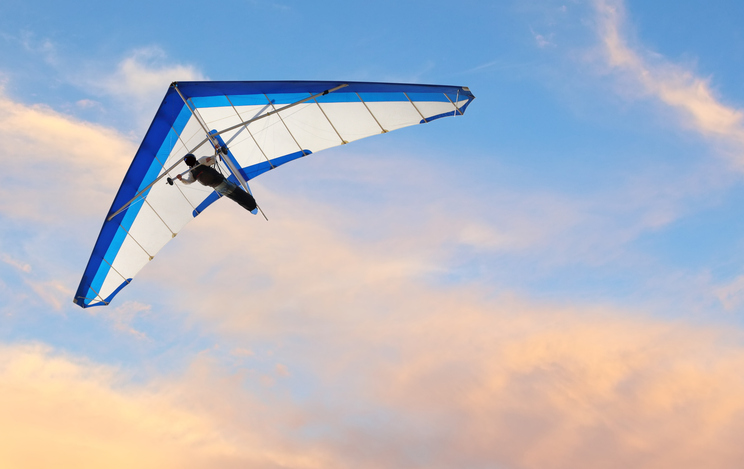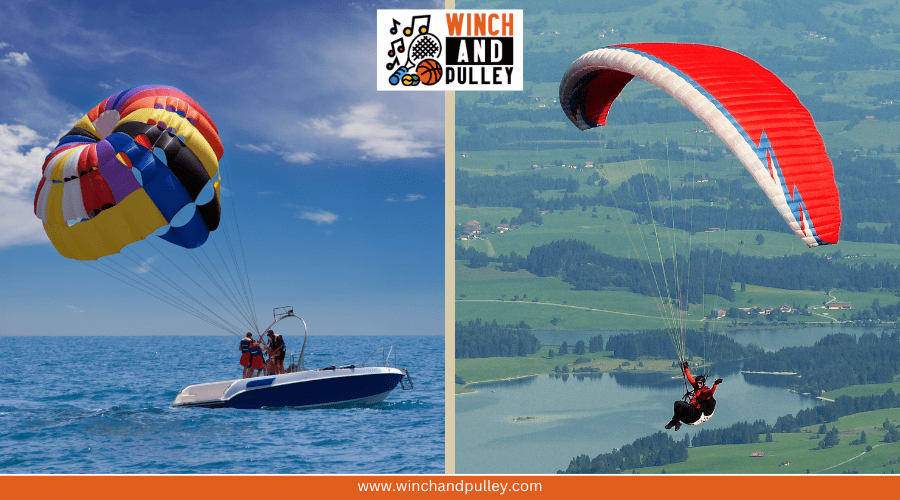Paragliding Acrobatics: Performing Stunts While Paragliding

Explore the exhilarating realm of paragliding acrobatics, where pilots perform spectacular aerial stunts like spins and spirals. These maneuvers require exceptional skill and precise control, underscoring the importance of mastering techniques and adhering to safety protocols.
Curious about how pilots train for such audacious acts or what specialized equipment ensures their safety? Join us as we delve into the essentials of acro paragliding, from rigorous training regimens to perfecting advanced tricks that redefine the boundaries of aerial performance.
Key Takeaways
- Acro paragliding involves executing high-risk aerial stunts that test the limits of a glider's capabilities.
- Mastery of maneuvers such as the deep spiral and full stall is essential in acro paragliding.
- Safety gear, including specialized harnesses and reserve parachutes, is crucial for performing these stunts.
- Advanced training and consistent practice under experienced supervision ensure safe progression in acro paragliding.
- Techniques like the Helicopter, SAT, and Infinity Tumbling require precise control and advanced skill levels.
Understanding Paragliding Acrobatics

Acro paragliding is an advanced and exhilarating discipline that involves performing high-risk aerial stunts such as spins, spirals, and stalls. These maneuvers push the limits of your glider's capabilities, requiring not just flying skills but also mastery of complex aerial tricks.
One key move in acro paragliding is the deep spiral. This maneuver involves a sharp, high-speed downward spiral that generates significant G-forces, showcasing precise glider handling. Achieving a deep spiral demands a solid grasp of your glider's dynamics and exceptional control over your movements.
Safety is paramount in acro paragliding. Each stunt, whether a spin, deep spiral, or another complex trick, requires advanced skills, training, and experience. Understanding the risks and proper techniques for these maneuvers is crucial. This knowledge not only enhances your performance but also ensures you can enjoy the thrilling experience of acro paragliding without unnecessary risks.
Essential Gear for Acro Paragliding
To perform acro paragliding stunts safely and effectively, you'll need specialized gear tailored specifically for this extreme sport. First and foremost, a harness designed for acro paragliding is essential. It should offer comfort, support, and allow for effortless maneuverability during complex stunts. A well-designed harness is crucial for maintaining control and stability during acrobatic maneuvers.
Equally important is a reserve parachute. In emergency situations where your main canopy fails, this backup can be a lifesaver. Ensure it's easily accessible and properly packed before taking off.
A helmet is non-negotiable for head safety. The high-speed maneuvers and potential for impacts make it an essential piece of gear for protecting against head injuries. Gloves are also critical. They provide protection and ensure a firm grip on the brake toggles, which is necessary for the precise control required to execute stunts accurately and confidently.
Lastly, the paraglider itself must be suitable for acro paragliding. These specialized wings are designed to withstand the stresses of rapid and extreme maneuvers, ensuring both performance and safety. Equip yourself with this essential gear, and you'll be ready to push the limits in the sky safely and effectively.
Training and Preparation
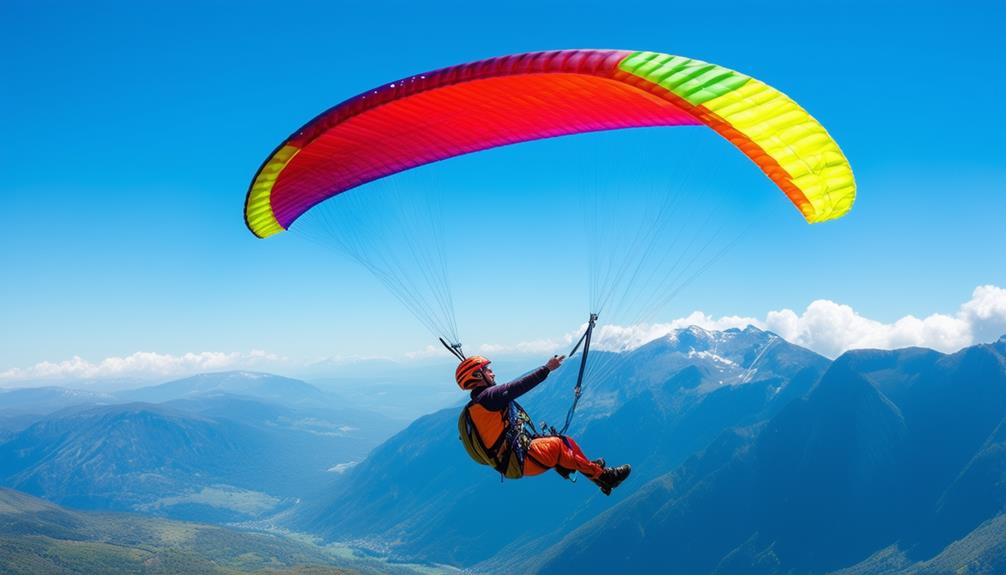
When starting acro paragliding, prioritizing safety gear and skill development is essential. Mastering maneuvers like Deep Spiral and Full Stall, along with ensuring your harness and brake lines are properly adjusted, is crucial. Regular training and guidance from experienced pilots will help you progress safely and effectively.
Safety Gear Essentials
Ensuring you have the proper safety gear, such as a well-fitted harness, helmet, and reserve parachute, is crucial for paragliding acrobatics. Proper safety gear can mean the difference between a thrilling experience and a hazardous mishap. A properly adjusted harness keeps you securely attached to your glider while allowing the flexibility needed for complex maneuvers.
Your helmet is indispensable. It protects your head from potential impacts during rough landings or unexpected turbulence. A helmet specifically designed for paragliding offers the best protection.
Equally important is the reserve parachute. In case of main parachute failure or an uncontrollable situation, the reserve parachute is your lifesaver. Regularly inspect and maintain your reserve parachute to ensure it's in peak condition.
Appropriate clothing also plays a role in safety. It protects you from the elements and reduces injury risk during maneuvers. Always inspect all your gear before every flight. Regular maintenance and checks are vital to ensure everything functions correctly, keeping you safe as you execute thrilling paragliding acro stunts.
Skill Development Techniques
Mastering paragliding acrobatics involves rigorous training and meticulous preparation. To excel in acro paragliding, consistent practice and gradual progression are essential. Start with fundamental maneuvers like the Deep Spiral and Full Stall, as they form the basis for more complex stunts.
Advanced techniques such as the Horseshoe and Tail Slide require precise control and extensive rehearsal. Before attempting these maneuvers, ensure your harness and brake lines are properly adjusted. Understanding the correct methods for entering and exiting these stunts is crucial for maintaining control and safety.
Advanced maneuvers carry inherent safety risks. Therefore, it's crucial to exercise extreme caution and build experience gradually. Regular training sessions focusing on gradual progression are key to honing your skills.
Working with a qualified instructor will greatly aid your skill development. They can provide valuable insights, correct your techniques, and ensure steady progress. Always prioritize safety and avoid rushing through the learning phases. With dedication and the right approach, you can effectively master acro paragliding stunts.
Safety Measures
When engaging in paragliding acrobatics, prioritizing safety measures is essential. Begin with a comprehensive gear checklist to ensure you have all necessary equipment, including a dependable rescue parachute. Additionally, familiarize yourself with emergency protocols to manage unforeseen situations effectively.
Essential Gear Checklist
To stay safe during paragliding acrobatics, essential gear includes a reserve parachute, helmet, and acro harness. These items form the backbone of your safety arsenal. Specifically designed acrobatic gear ensures proper balance, control, and protection mid-air. For instance, an acro harness provides superior support and control during complex maneuvers compared to a standard harness.
Safety extends beyond just having the right equipment. Regularly inspecting and maintaining your gear ensures optimal functionality when you need it most. Understanding weight range and wing loading is also critical for safely executing acrobatic moves.
Emergency communication devices are another crucial component. A GPS tracker can help rescuers locate you quickly if needed, while a radio allows you to stay in touch with your ground crew or fellow pilots. These devices can be life-saving in emergency situations.
Here's a quick gear checklist to keep you safe:
- Reserve Parachute: Always have a backup in case your main wing fails.
- Helmet: Protects your head from potential impacts.
- Acro Harness: Provides better support and control for acrobatic maneuvers.
- GPS Tracker: Enables quick location by rescuers in an emergency.
- Radio: Keeps you in communication with your ground crew or fellow pilots.
Emergency Protocols
Having the right gear is just the start; knowing how to react in emergencies is crucial in paragliding acrobatics. One of the key emergency protocols is recognizing when to deploy your reserve parachute. If a significant collapse occurs during a maneuver, your immediate action should be to release the brakes and center yourself. This helps you regain control and stabilize your flight.
In acro paragliding, handling riser twists and a loss of control are critical safety measures. Practicing these scenarios ensures you're prepared to react swiftly and effectively. If you experience a riser twist, remain calm and work systematically to untwist them, using small, controlled movements to avoid further complications.
Your emergency protocols should also include practicing controlled exits from maneuvers. This practice reduces the risk of accidents by ensuring you can safely disengage from complex stunts.
Deep Spiral Technique

Mastering the Deep Spiral technique is essential for any pilot venturing into the exhilarating realm of acro paragliding. This maneuver enables you to achieve a descent rate exceeding 20 meters per second and rotation speeds up to 110 km/h. Beyond the adrenaline rush, comprehending the mechanics and adhering to safety protocols is crucial.
To perform a deep spiral, progressively pull one brake while maintaining precise control. Vigilance regarding your altitude and surroundings is paramount, as this maneuver results in rapid height loss. Practicing proper exit techniques is essential to avoid hazardous situations.
Safety First: Always be ready to deploy your reserve parachute, especially when flying close to the ground.
Gradual Exit: Release the brake slowly to prevent significant collapses and ensure stability.
Center Yourself: Ensure you're centered in your harness to avoid asymmetric forces.
Mastering the Full Stall
Understanding and mastering the full stall maneuver is crucial for regaining control of your paraglider after critical flight mistakes. This acrobatic technique can be a lifesaver in challenging situations. To perform a full stall, you must practice pulling the brakes symmetrically until your glider loses all forward momentum and begins to descend vertically.
A key aspect of the full stall is the release phase. You must release the brakes slowly and symmetrically to stabilize the glider. Releasing them too quickly or when the glider is behind you can cause it to shoot forward violently, creating a hazardous situation. Timing and technique are essential here.
Properly entering and exiting the full stall is crucial to prevent collapses or an uncontrollable spiral. Be mindful of the risks involved: improper re-inflation control can lead to collapses, and letting one side of the glider dive can result in spirals.
Performing the Horseshoe
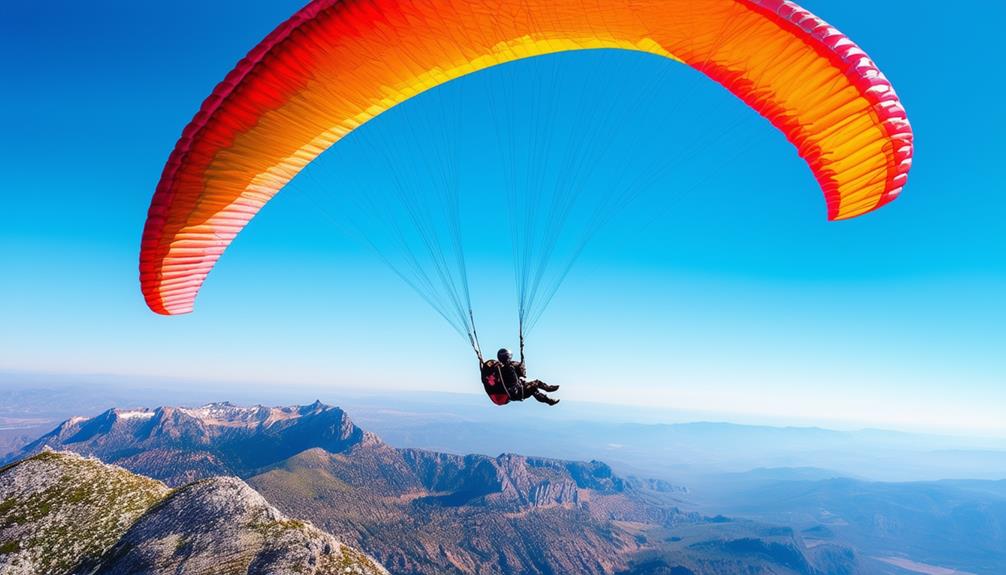
To execute the Horseshoe maneuver in acro paragliding, you need to pull both brake lines evenly, forming a U shape with your glider. This visually striking stunt, a staple in acrobatics, demands precision and control. By pulling the brake lines, you reduce horizontal speed, making the glider assume the characteristic U shape in the air. This maneuver was a common feature in aerobatics competitions until 2004, highlighting the pilot's skill.
Key Points for the Horseshoe Maneuver:
- Even Brake Pull: Ensure both brake lines are pulled evenly to maintain balance.
- Speed Control: A reduction in horizontal speed is expected; remain calm.
- Gradual Exiting: Permit the glider to regain speed gradually for a smooth exit.
Avoid pulling the lines too quickly, as this can cause instability. Aim for a steady, controlled approach to maintain the U shape. When ready to exit, let the glider slowly gain speed to transition smoothly back to normal flight. Mastering the Horseshoe won't only enhance your acrobatics repertoire but also improve your overall control and precision in paragliding.
Executing Spins
Mastering spins adds a dynamic and challenging dimension to your acro paragliding skills. Spins involve your paraglider turning backward on one side, creating oscillations throughout the maneuver. As the pilot, you'll swing forward and backward under the paraglider, with one side's tip collapsing to the front.
Executing spins safely requires precise control and experience. Proper techniques for entering and exiting spins are crucial to avoid potential risks like riser twists and loss of control. Managing oscillations and maintaining stability throughout the maneuver demands a keen understanding of these paragliding stunts.
Here's a quick guide to help you grasp the essentials:
| Step | Description |
|---|---|
| Entry | Pull the brake line on one side while leaning in the same direction. |
| Initiation | Maintain pressure on the brake to initiate the spin. |
| Control | Adjust brake pressure to manage oscillations and keep the spin stable. |
| Exit | Gradually release the brake and shift your weight back to neutral. |
| Recovery | Ensure the wing stabilizes and check for any riser twists. |
Understanding and practicing proper techniques are necessary to safely execute spins in acro paragliding. With consistent practice, you will master this thrilling stunt and add another impressive move to your acro repertoire.
Tail Slide Maneuvers
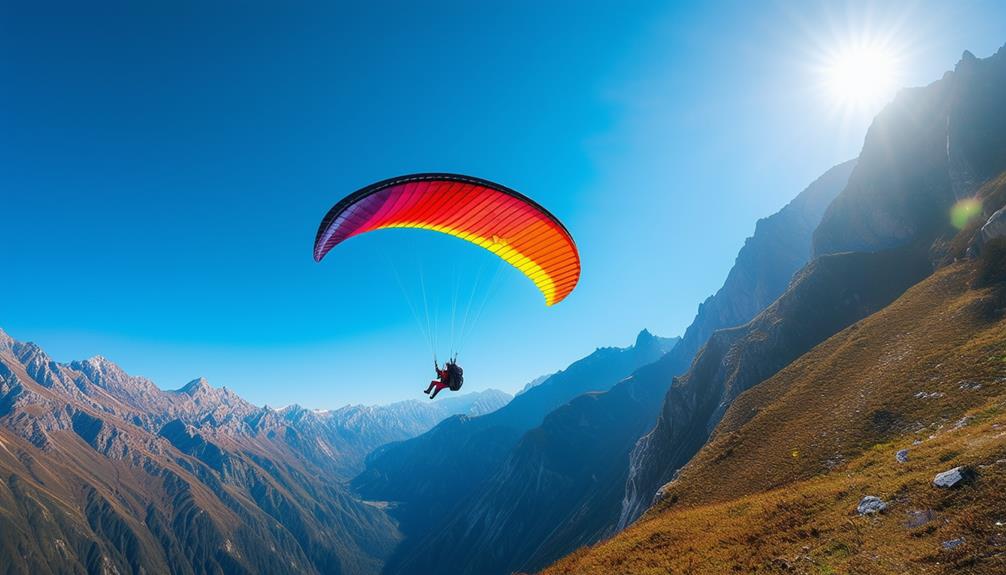
Tail slide maneuvers are a thrilling yet demanding aspect of acro paragliding, requiring mastery over the delicate balance between a deep stall and a full stall. Successfully executing this maneuver involves navigating the fine line between these two states with precise control. These stunts aren't just for show; they're often integral to acro paragliding qualifications, making them essential for any serious pilot.
To perform tail slide maneuvers safely, it's crucial to be at an appropriate skill level and use suitable equipment. The risk of a full stall is significant, so proper execution is paramount. Quick and symmetrical exits are essential for a safe recovery, ensuring you regain stable flight.
Key considerations include:
- Skill Level: Ensure you're adequately trained and experienced before attempting tail slide maneuvers.
- Equipment: Use gear specifically designed for acro paragliding to handle the demands of these stunts.
- Safety: Prioritize safe execution and be acutely aware of the associated risks.
Mastering tail slide maneuvers can significantly enhance your acro paragliding skills while adding an exhilarating dimension to your flying experience.
Advanced Stunts and Tricks
Let's delve into some advanced paragliding acrobatics that push the boundaries of the sport. You'll explore Wingovers and Spirals, which involve dynamic weight shifting, along with Helicopters and SATs, known for their dramatic spins and rotations.
Wingovers and Spirals
Mastering advanced paragliding maneuvers like wingovers and spirals demands precise control and a deep understanding of your equipment and aerodynamics.
Wingovers
Wingovers involve a pendulum motion, where you alternately increase altitude and speed. To execute wingovers smoothly, you need to master precise weight shifting and brake control. This maneuver requires you to feel and respond to the wing's dynamic motion, making it a significant challenge for your paragliding skills.
Spirals
Spirals are high-speed, steeply banked turns that can generate rapid descent rates, sometimes exceeding 20 meters per second. They offer an adrenaline-pumping experience and are an effective way to lose altitude quickly. When performing spirals, it's important to manage your speed and g-forces to avoid overloading your wing and yourself.
Tips for Mastery
To get the most out of these stunts, consider the following:
- Practice Regularly: Consistent practice helps you refine your techniques and develop muscle memory.
- Safety Equipment: Always use appropriate safety gear, including a reserve parachute and helmet.
- Weather Conditions: Perform advanced stunts only in suitable weather conditions to maintain stability and control.
Helicopters and SATs
When delving into advanced paragliding stunts, Helicopters and SATs demand exceptional skill and precision from the pilot. These maneuvers are among the top acro techniques in paragliding.
The Helicopter maneuver involves creating a controlled spin that mimics a helicopter's rotor blade motion, resulting in a low descent rate. This requires precise control and a deep understanding of aerodynamics to maintain balance and prevent collapse.
SAT, short for Spiral Dive with Automatic Turn, is another thrilling stunt where you spin around the glider's center axis. The dynamics of this maneuver are intense, necessitating high skill levels and meticulous execution. To perform these stunts safely, extensive training and experience are essential.
Here's a quick comparison:
| Maneuver | Description | Skill Level |
|---|---|---|
| Helicopter | Controlled spin, mimics rotor blade motion | Advanced |
| SAT | Dynamic spin around glider's center axis | Advanced |
| Descent Rate | Low | High |
| Training Need | High precision and control | Extensive |
Mastering these stunts will significantly enhance your acro paragliding skills, making you one of the elite acro pilots in the sky.
Infinity Tumbling Techniques
Building on the complexity of Helicopters and SATs, Infinity Tumbling elevates acro paragliding to an unparalleled level of spectacle and skill. This advanced maneuver involves executing consecutive rotations and tumbles while maintaining precise control and stability. It requires impeccable timing and coordination to perform successfully, showcasing your mastery of the glider.
Infinity tumbling is a visually stunning maneuver that demands a high level of expertise. As you perform multiple rotations, you must keep the glider stable and respond quickly to any changes in airflow or balance. This isn't just about spinning; it's about demonstrating your ability to manage complex aerial dynamics.
- Mastery of Control: Infinity tumbling challenges you to maintain control during rapid, consecutive rotations.
- Precision Timing: Each pirouette and tumble must be timed perfectly to avoid losing stability.
- Visual Spectacle: This advanced stunt is as much about visual impact as it's about technical skill.
In acro paragliding, infinity tumbling stands out as a demonstration of a pilot's advanced capabilities. It's not just a trick; it's a display of precision, control, and the art of aerial acrobatics.
Frequently Asked Questions
What Are the Acro Maneuvers for Paragliding?
You're asking about acro maneuvers in paragliding. These include the Deep Spiral, Full Stall, Horseshoe, Spin, and Tail Slide. Each maneuver demands precise control, proper technique, and advanced skills to execute safely.
What Is Acrobatic Paragliding?
Acrobatic paragliding involves pilots performing advanced aerial maneuvers such as spins, spirals, and flips. This high-risk yet exhilarating aspect of the sport demands specialized training, considerable skill, and extensive experience.
What Are the Techniques of Paragliding?
Mastering paragliding involves several key techniques. Learn the Deep Spiral and Full Stall for essential control. Practice the Horseshoe for a unique descent method. Perfect the Tail Slide and Spin for precision maneuvers. Always prioritize thorough preparation and safety protocols.
What Could Go Wrong Paragliding?
Paragliding can present several risks including experiencing G-forces, wing collapses, and loss of control. Riser twists, challenges during ground approaches, and improper exits from maneuvers are also potential hazards. Mistakes can result in accidents leading to injuries or worse. Therefore, thorough training and strict adherence to safety precautions are essential.
Conclusion
Now that you have a solid foundation in paragliding acrobatics, it's time to elevate your experience. With the right equipment, comprehensive training, and a strong emphasis on safety, you can master exhilarating maneuvers like the Deep Spiral and Tail Slide. Precision and caution are paramount, ensuring that acro paragliding remains a thrilling and safe pursuit. Gear up, stay vigilant, and embrace the breathtaking adventure that awaits you in the skies!

